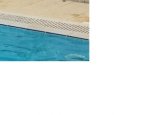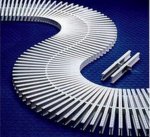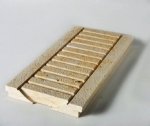Hello every one!
This season has been great so far except for a minor issue.
Water is sparkling clear first of all and has been since April. However compared to last year I need to run my SWG at 50% compared to 30% last year to keep my target FC for my CYA level. My CYA is 60 this year and it was also 60 last year.
[ I manage to get off with lower than 70-80 because I have an oversized Salt & Swim Hayward SWG (the cell has lasted by the way for 2 1/2 years for a cost of $200 , I dont winterize the pool it is open year round) and run the (undersized) pump 14-16/24 from May- September 8-10/24 October-December 4-6/24 January, pump off February and March and so on..Very hot summers here in southern Greece and mild winters.]
There is obviously something in the pool that uses more chlorine than last year, right? So I tried to find what it is. Ladder was clean, so were the light niches BUT ....My pool has an oveflow cannal and reservoir. The cannal is covered with white hard stripes of plastic that connect to one another in the middle. Every one has a male and female connecting "point' and so you can connect as many as you like in a row, plus they can curve if you like, so I end up having about 30 of these/1 metre for a total of over 1000 to cover the entire pool. As soon as the rain season starts I stop using the overflow canal and function of the pool bacause all of the dirty rain water from around the pool used to enter the canal due to improper alignment and end up in the pool. So I always thought these plastic cover of the canal where clean or so they seemed....until i dismantled some. There was algae inside the connections!! I started to clean every single one of them in a different location of my yard with a pressure washer and rinse them in a dilute chlorine solution. It took me a month 3hours/day but i finally finished a couple of weeks ago! (they cost 25$/meter I saved 1000$ ) I also scrubbed the inside of the canal thoroughly with dilute chlorine water and the inside of the overflow reservoir after emptying it.
) I also scrubbed the inside of the canal thoroughly with dilute chlorine water and the inside of the overflow reservoir after emptying it.
I then refilled my reservoir , added cya and salt to it (its about 5000liter) and went back to normal overflowing operation.
So i thought I had it all figured out and I could reduce the SWG but....no I couldn't. It still needed 50% to keep FC at 5. Plus I never saw a cc of 0. I decided to boost the FC .
(with TF 100)
Baseline
ph 7,4 (Hayward Ez pH ayto regulated and corectly calibrated )
FC 5
CC 0,5
CH 350
Cya 60
TA 120 (the overflow canal aerates the water as it falls in the reservoir like a little waterfall)
Salt 3200
borate 10-15?
temp 28 celcius
I added 10000ml of 12% chlorine I had left from last year yesterday at 11am. Had the SWG at 100% pump 24/24. Half an hour later FC 9 (!!! it really lost its power since last year it should have gone to FC 20) , CC0,5
We then went to the sea to swim.....hoping the SWG would do its job (last year it managed to boost FC by 5 in a matter of 6 hours)
4pm FC 10 CC 0,5 nothing added
5pm FC 11 CC 0,5 nothing added
6pm FC 12 CC 0,5 nothing added
7pm FC 12 CC 0 !!!nothing added
8pm FC 12 CC 0 nothing added
10pm FC 12 CC 0 nothing added
11pm FC 12 CC 0 nothing added turned SWG off and crossed fingers
This morning FC 11 CC 0,5.
Questions;
1. Do you think I am missing something here?
2. Is my OCLT valid with a FC of 12 and is it a pass?
3. What could be using up this extra chlorine so I cant dial down my SWG (bather load is exactly the same last year and this year)? Last year 100% ALWAYS brought the FC up in a matter of 6 hours this year it is hardly keeping up
4. Should I SLAM just in case? (my family will hate me if i do this right now) remember my water is better than ever!
This season has been great so far except for a minor issue.
Water is sparkling clear first of all and has been since April. However compared to last year I need to run my SWG at 50% compared to 30% last year to keep my target FC for my CYA level. My CYA is 60 this year and it was also 60 last year.
[ I manage to get off with lower than 70-80 because I have an oversized Salt & Swim Hayward SWG (the cell has lasted by the way for 2 1/2 years for a cost of $200 , I dont winterize the pool it is open year round) and run the (undersized) pump 14-16/24 from May- September 8-10/24 October-December 4-6/24 January, pump off February and March and so on..Very hot summers here in southern Greece and mild winters.]
There is obviously something in the pool that uses more chlorine than last year, right? So I tried to find what it is. Ladder was clean, so were the light niches BUT ....My pool has an oveflow cannal and reservoir. The cannal is covered with white hard stripes of plastic that connect to one another in the middle. Every one has a male and female connecting "point' and so you can connect as many as you like in a row, plus they can curve if you like, so I end up having about 30 of these/1 metre for a total of over 1000 to cover the entire pool. As soon as the rain season starts I stop using the overflow canal and function of the pool bacause all of the dirty rain water from around the pool used to enter the canal due to improper alignment and end up in the pool. So I always thought these plastic cover of the canal where clean or so they seemed....until i dismantled some. There was algae inside the connections!! I started to clean every single one of them in a different location of my yard with a pressure washer and rinse them in a dilute chlorine solution. It took me a month 3hours/day but i finally finished a couple of weeks ago! (they cost 25$/meter I saved 1000$
I then refilled my reservoir , added cya and salt to it (its about 5000liter) and went back to normal overflowing operation.
So i thought I had it all figured out and I could reduce the SWG but....no I couldn't. It still needed 50% to keep FC at 5. Plus I never saw a cc of 0. I decided to boost the FC .
(with TF 100)
Baseline
ph 7,4 (Hayward Ez pH ayto regulated and corectly calibrated )
FC 5
CC 0,5
CH 350
Cya 60
TA 120 (the overflow canal aerates the water as it falls in the reservoir like a little waterfall)
Salt 3200
borate 10-15?
temp 28 celcius
I added 10000ml of 12% chlorine I had left from last year yesterday at 11am. Had the SWG at 100% pump 24/24. Half an hour later FC 9 (!!! it really lost its power since last year it should have gone to FC 20) , CC0,5
We then went to the sea to swim.....hoping the SWG would do its job (last year it managed to boost FC by 5 in a matter of 6 hours)
4pm FC 10 CC 0,5 nothing added
5pm FC 11 CC 0,5 nothing added
6pm FC 12 CC 0,5 nothing added
7pm FC 12 CC 0 !!!nothing added
8pm FC 12 CC 0 nothing added
10pm FC 12 CC 0 nothing added
11pm FC 12 CC 0 nothing added turned SWG off and crossed fingers
This morning FC 11 CC 0,5.
Questions;
1. Do you think I am missing something here?
2. Is my OCLT valid with a FC of 12 and is it a pass?
3. What could be using up this extra chlorine so I cant dial down my SWG (bather load is exactly the same last year and this year)? Last year 100% ALWAYS brought the FC up in a matter of 6 hours this year it is hardly keeping up
4. Should I SLAM just in case? (my family will hate me if i do this right now) remember my water is better than ever!


 I could have written that better.
I could have written that better.






